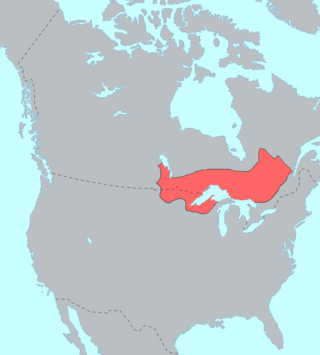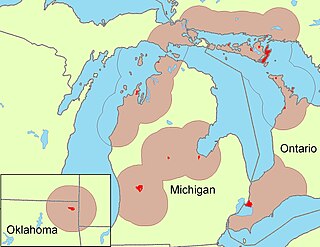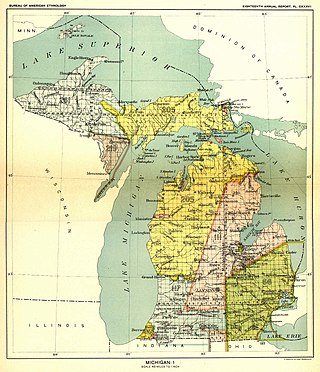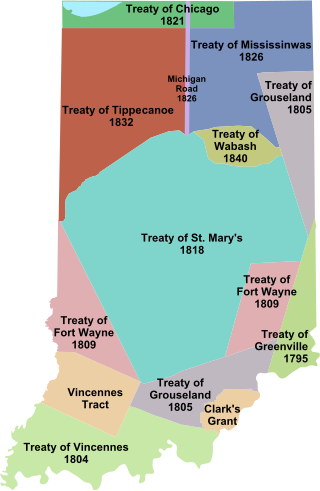
The Ojibwe are an Anishinaabe people whose homeland covers much of the Great Lakes region and the northern plains, extending into the subarctic and throughout the northeastern woodlands. Ojibweg, being Indigenous peoples of the Northeastern Woodlands and of the subarctic, are known by several names, including Ojibway or Chippewa. As a large ethnic group, several distinct nations also understand themselves to be Ojibwe as well, including the Saulteaux, Nipissings, and Oji-Cree.

The Potawatomi, also spelled Pottawatomi and Pottawatomie, are a Native American people of the Great Plains, upper Mississippi River, and western Great Lakes region. They traditionally speak the Potawatomi language, a member of the Algonquian family. The Potawatomi call themselves Neshnabé, a cognate of the word Anishinaabe. The Potawatomi are part of a long-term alliance, called the Council of Three Fires, with the Ojibway and Odawa (Ottawa). In the Council of Three Fires, the Potawatomi are considered the "youngest brother". Their people are referred to in this context as Bodéwadmi, a name that means "keepers of the fire" and refers to the council fire of three peoples.

The Odawa are an Indigenous American people who primarily inhabit land in the Eastern Woodlands region, now in jurisdictions of the northeastern United States and southeastern Canada. Their territory long preceded the creation of the current border between the two countries in the 18th and 19th centuries.
The Council of Three Fires is a long-standing Anishinaabe alliance of the Ojibwe, Odawa, and Potawatomi North American Native tribes.

The Treaty of Saginaw, also known as the Treaty with the Chippewa, was made between Gen. Lewis Cass and Chief Mash Kee Yosh, Chief John Okemos, Chief Wasso and other Native American tribes of the Great Lakes region in what is now the United States, on September 24, 1819, proclaimed by the President of the United States on March 25, 1820, and placed in law as 7 Stat. 203.

The Treaty of Chicago may refer to either of two treaties made and signed in the settlement that became Chicago, Illinois between the United States and the Odaawaa, Ojibwe, and Bodéwadmi Native American peoples. The first was in 1821 and the second in 1833.

The Treaty of Detroit was a treaty between the United States and the Ottawa, Chippewa, Wyandot and Potawatomi Native American nations. The treaty was signed in Detroit, Michigan on November 17, 1807, with William Hull, governor of the Michigan Territory and superintendent of Indian affairs, the sole representative of the U.S.

The Grand Traverse Band of Ottawa and Chippewa Indians is a federally recognized Native American tribe located in northwest Michigan on the Leelanau Peninsula. Sam McClellan is the current tribal chairman, elected in June 2016 to a four-year term after succeeding Al Pedwaydon, who served from 2012 to 2016.

The Treaty of Fort Meigs, also called the Treaty of the Maumee Rapids, formally titled, "Treaty with the Wyandots, etc., 1817", was the most significant Indian treaty by the United States in Ohio since the Treaty of Greenville in 1795. It resulted in cession by bands of several tribes of nearly all their remaining Indian lands in northwestern Ohio. It was the largest wholesale purchase by the United States of Indian land in the Ohio area. It was also the penultimate one; a small area below the St. Mary's River and north of the Greenville Treaty Line was ceded in the Treaty of St. Mary's in 1818.

The Nottawaseppi Huron Band of Potawatomi (NHBP) is a federally-recognized tribe of Potawatomi in the United States. The tribe achieved federal recognition on December 19, 1995, and currently has approximately 1500 members.
Note: There are multiple treaties referred to as Treaty with the Potawatomi. See Treaty with the Potawatomi for others.
Egushawa, also spelled Egouch-e-ouay, Agushaway, Agashawa, Gushgushagwa, Negushwa, and many other variants, was a war chief and principal political chief of the Ottawa tribe of North American Indians. His name is loosely translated as "The Gatherer" or "Brings Together". He was a prominent leader among the Detroit Ottawa, a prominent group in southeast Michigan and northwest Ohio. Egushawa is considered a successor to Chief Pontiac. As a leader in two wars against the United States, Egushawa was one of the most influential Native Americans of the Great Lakes region in the late eighteenth century.
Kalamazoo is the name of the Kalamazoo River in U.S. state of Michigan, and several settled places named after it, including the city of Kalamazoo, Kalamazoo Township, and Kalamazoo County. There is uncertainty concerning the origin of the river's name, but several theories have been suggested.
Anishinaabe tribal political organizations are political consortiums of Anishinaabe nations that advocate for the political interests of their constituencies. Anishinaabe people of Canada are considered as First Nations, and of the United States as Native Americans.
Carey Mission was established in December 1822 by Baptist missionary Isaac McCoy among the Potawatomi tribe of American Indians on the St. Joseph River near Niles, Michigan, United States. It was named for English Baptist missionary William Carey. Its official nature and reputation made it a headquarters for settlers and an edge of the American frontier.

Indian removals in Indiana followed a series of the land cession treaties made between 1795 and 1846 that led to the removal of most of the native tribes from Indiana. Some of the removals occurred prior to 1830, but most took place between 1830 and 1846. The Lenape (Delaware), Piankashaw, Kickapoo, Wea, and Shawnee were removed in the 1820s and 1830s, but the Potawatomi and Miami removals in the 1830s and 1840s were more gradual and incomplete, and not all of Indiana's Native Americans voluntarily left the state. The most well-known resistance effort in Indiana was the forced removal of Chief Menominee and his Yellow River band of Potawatomi in what became known as the Potawatomi Trail of Death in 1838, in which 859 Potawatomi were removed to Kansas and at least forty died on the journey west. The Miami were the last to be removed from Indiana, but tribal leaders delayed the process until 1846. Many of the Miami were permitted to remain on land allotments guaranteed to them under the Treaty of St. Mary's (1818) and subsequent treaties.
The Match-e-be-nash-she-wish Band of Pottawatomi Indians of Michigan is a federally recognized tribe of Potawatomi people in Michigan named for a 19th-century Ojibwe chief. They were formerly known as the Gun Lake Band of Grand River Ottawa Indians, the United Nation of Chippewa, Ottawa and Pottawatomi Indians of Michigan, Inc., and the Gun Lake Tribe or Gun Lake Band. They are headquartered in Bradley, Michigan.

The Treaty of Prairie du Chien may refer to any of several treaties made and signed in Prairie du Chien, Wisconsin between the United States, representatives from the Sioux, Sac and Fox, Menominee, Iowa, Ho-Chunk and the Anishinaabeg Native American peoples.

Alexander Robinson, was a British-Ottawa chief born on Mackinac Island who became a fur trader and ultimately settled near what later became Chicago. Multilingual in Odawa, Potawatomi, Ojibwa, English and French, Robinson also helped evacuate survivors of the Fort Dearborn Massacre in 1812. In 1816, Robinson was a translator for native peoples during the Treaty of St. Louis. He became a Potawatomi chief in 1829 and in that year and in 1833, he and fellow Metis Billy Caldwell negotiated treaties on behalf of the United Nations of Ottawa, Chippewa, and Potawatomi with the United States. Although Robinson helped lead Native Americans across the Mississippi River in 1835, unlike Caldwell, Robinson returned to the Chicago area by 1840 and lived as a respected citizen in western Cook County until his death decades later.

The 1833 Treaty of Chicago was an agreement between the United States government and the Chippewa, Odawa, and Potawatomi tribes. It required them to cede to the United States government their 5,000,000 acres (2,000,000 ha) of land in Illinois, the Wisconsin Territory, and the Michigan Territory and to move west of the Mississippi River. In return, the tribes were given promises of various cash payments and tracts of land west of the Mississippi River. The treaty was one of the removal treaties to come after the passage of the Indian Removal Act. It was the second treaty referred to as the "Treaty of Chicago," after the 1821 Treaty of Chicago.












